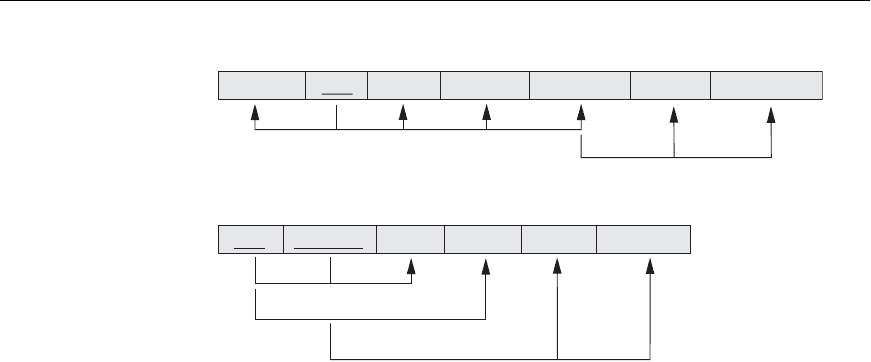Elmasri R., Navathe S.B. Fundamentals of Database Systems
Подождите немного. Документ загружается.


502 Chapter 15 Basics of Functional Dependencies and Normalization for Relational Databases
physical storage) level—how the tuples in a base relation are stored and updated.
This level applies only to schemas of base relations—which will be physically stored
as files—whereas at the logical level we are interested in schemas of both base rela-
tions and views (virtual relations). The relational database design theory developed
in this chapter applies mainly to base relations, although some criteria of appropri-
ateness also apply to views, as shown in Section 15.1.
As with many design problems, database design may be performed using two
approaches: bottom-up or top-down. A bottom-up design methodology (also
called design by synthesis) considers the basic relationships among individual attrib-
utes as the starting point and uses those to construct relation schemas. This
approach is not very popular in practice
1
because it suffers from the problem of
having to collect a large number of binary relationships among attributes as the
starting point. For practical situations, it is next to impossible to capture binary
relationships among all such pairs of attributes. In contrast, a top-down design
methodology (also called design by analysis) starts with a number of groupings of
attributes into relations that exist together naturally, for example, on an invoice, a
form, or a report. The relations are then analyzed individually and collectively, lead-
ing to further decomposition until all desirable properties are met. The theory
described in this chapter is applicable to both the top-down and bottom-up design
approaches, but is more appropriate when used with the top-down approach.
Relational database design ultimately produces a set of relations. The implicit goals
of the design activity are information preservation and minimum redundancy.
Information is very hard to quantify—hence we consider information preservation
in terms of maintaining all concepts, including attribute types, entity types, and
relationship types as well as generalization/specialization relationships, which are
described using a model such as the EER model. Thus, the relational design must
preserve all of these concepts, which are originally captured in the conceptual
design after the conceptual to logical design mapping. Minimizing redundancy
implies minimizing redundant storage of the same information and reducing the
need for multiple updates to maintain consistency across multiple copies of the
same information in response to real-world events that require making an update.
We start this chapter by informally discussing some criteria for good and bad rela-
tion schemas in Section 15.1. In Section 15.2, we define the concept of functional
dependency, a formal constraint among attributes that is the main tool for formally
measuring the appropriateness of attribute groupings into relation schemas. In
Section 15.3, we discuss normal forms and the process of normalization using func-
tional dependencies. Successive normal forms are defined to meet a set of desirable
constraints expressed using functional dependencies. The normalization procedure
consists of applying a series of tests to relations to meet these increasingly stringent
requirements and decompose the relations when necessary. In Section 15.4, we dis-
1
An exception in which this approach is used in practice is based on a model called the binary relational
model. An example is the NIAM methodology (Verheijen and VanBekkum, 1982).
15.1 Informal Design Guidelines for Relation Schemas 503
cuss more general definitions of normal forms that can be directly applied to any
given design and do not require step-by-step analysis and normalization. Sections
15.5 to 15.7 discuss further normal forms up to the fifth normal form. In Section
15.6 we introduce the multivalued dependency (MVD), followed by the join
dependency (JD) in Section 15.7. Section 15.8 summarizes the chapter.
Chapter 16 continues the development of the theory related to the design of good
relational schemas. We discuss desirable properties of relational decomposition—
nonadditive join property and functional dependency preservation property. A
general algorithm that tests whether or not a decomposition has the nonadditive (or
lossless) join property (Algorithm 16.3 is also presented). We then discuss properties
of functional dependencies and the concept of a minimal cover of dependencies. We
consider the bottom-up approach to database design consisting of a set of algo-
rithms to design relations in a desired normal form. These algorithms assume as
input a given set of functional dependencies and achieve a relational design in a tar-
get normal form while adhering to the above desirable properties. In Chapter 16 we
also define additional types of dependencies that further enhance the evaluation of
the goodness of relation schemas.
If Chapter 16 is not covered in a course, we recommend a quick introduction to the
desirable properties of decomposition and the discussion of Property NJB in
Section 16.2.
15.1 Informal Design Guidelines
for Relation Schemas
Before discussing the formal theory of relational database design, we discuss four
informal guidelines that may be used as measures to determine the quality of relation
schema design:
■
Making sure that the semantics of the attributes is clear in the schema
■
Reducing the redundant information in tuples
■
Reducing the NULL values in tuples
■
Disallowing the possibility of generating spurious tuples
These measures are not always independent of one another, as we will see.
15.1.1 Imparting Clear Semantics to Attributes in Relations
Whenever we group attributes to form a relation schema, we assume that attributes
belonging to one relation have certain real-world meaning and a proper interpreta-
tion associated with them. The semantics of a relation refers to its meaning result-
ing from the interpretation of attribute values in a tuple. In Chapter 3 we discussed
how a relation can be interpreted as a set of facts. If the conceptual design described
in Chapters 7 and 8 is done carefully and the mapping procedure in Chapter 9 is fol-
lowed systematically, the relational schema design should have a clear meaning.

504 Chapter 15 Basics of Functional Dependencies and Normalization for Relational Databases
DEPARTMENT
DnumberDname
Ename Bdate Address Dnumber
EMPLOYEE
P.K.
P.K.
F.K.
Pname Pnumber Plocation Dnum
PROJECT F.K.
F.K.
DEPT_LOCATIONS
Dnumber Dlocation
P.K.
P.K.
Pnumber Hours
WORKS_ON
F.K. F.K.
P.K.
F.K.
Ssn
Dmgr_ssn
Ssn
Figure 15.1
A simplified COMPANY relational
database schema.
In general, the easier it is to explain the semantics of the relation, the better the rela-
tion schema design will be. To illustrate this, consider Figure 15.1, a simplified ver-
sion of the
COMPANY relational database schema in Figure 3.5, and Figure 15.2,
which presents an example of populated relation states of this schema. The meaning
of the
EMPLOYEE relation schema is quite simple: Each tuple represents an
employee, with values for the employee’s name (
Ename), Social Security number
(
Ssn), birth date (Bdate), and address (Address), and the number of the department
that the employee works for (
Dnumber). The Dnumber attribute is a foreign key that
represents an implicit relationship between
EMPLOYEE and DEPARTMENT.The
semantics of the
DEPARTMENT and PROJECT schemas are also straightforward:
Each
DEPARTMENT tuple represents a department entity, and each PROJECT tuple
represents a project entity. The attribute
Dmgr_ssn of DEPARTMENT relates a depart-
ment to the employee who is its manager, while
Dnum of PROJECT relates a project
to its controlling department; both are foreign key attributes. The ease with which
the meaning of a relation’s attributes can be explained is an informal measure of how
well the relation is designed.

15.1 Informal Design Guidelines for Relation Schemas 505
Ename
EMPLOYEE
Smith, John B.
Wong, Franklin T.
Zelaya, Alicia J.
Wallace, Jennifer S.
Narayan, Ramesh K.
English, Joyce A.
Jabbar, Ahmad V.
Borg, James E.
999887777
123456789
333445555
453453453
987654321
666884444
987987987
888665555
666884444
123456789
123456789
333445555
453453453
453453453
333445555
333445555
333445555
999887777
987987987
999887777
987987987
987654321
987654321
888665555
3
1
2
2
1
2
3
10
20
10
30
10
30
30
20
20
40.0
32.5
7.5
10.0
20.0
20.0
10.0
10.0
10.
0
35.0
30.0
10.0
5.0
20.0
15.0
Null
1937-11-10
1968-07-19
1965-01-09
1955-12-08
1972-07-31
1969-03-29
1941-06-20
1962-09-15
Bdate
3321 Castle, Spring, TX
731 Fondren, Houston, TX 5
638 Voss, Houston, TX
5631 Rice, Houston, TX
980 Dallas, Houston, TX
450 Stone, Houston, TX
291Berry, Bellaire, TX
975 Fire Oak, Humble, TX
Address
4
5
5
4
1
4
5
Dnumber
Dname
DEPARTMENT
Research
Administration
Headquarters 888665555
333445555
987654321
Dnumber
5
1
4
DEPT_LOCATIONS
1
4
5
Dnumber
Houston
Dlocation
Bellaire
Stafford
Houston
Sugarland
5
5
PROJECT
ProductX
ProductY
ProductZ
Pname
1
Pnumber Plocation Dnum
3
2
20
10
Reorganization
30
5
5
5
1
4
4
Bellaire
Houston
Sugarland
Houston
Stafford
StaffordNewbenefits
Computerization
WORKS_ON
Pnumber Hours
Ssn
Dmgr_ssn
Ssn
Figure 15.2
Sample database state for the relational database schema in Figure 15.1.

506 Chapter 15 Basics of Functional Dependencies and Normalization for Relational Databases
Ssn
EMP_PROJ
(b)
(a)
FD1
FD2
FD3
Pnumber Hours Ename Pname Plocation
Ename Ssn
EMP_DEPT
Bdate Address Dnumber Dname Dmgr_ssn
Figure 15.3
Two relation schemas
suffering from update
anomalies. (a)
EMP_DEPT and (b)
EMP_PROJ.
The semantics of the other two relation schemas in Figure 15.1 are slightly more
complex. Each tuple in
DEPT_LOCATIONS gives a department number (Dnumber)
and one of the locations of the department (
Dlocation). Each tuple in WORKS_ON
gives an employee Social Security number (Ssn), the project number of one of the
projects that the employee works on (
Pnumber), and the number of hours per week
that the employee works on that project (
Hours). However, both schemas have a
well-defined and unambiguous interpretation. The schema
DEPT_LOCATIONS rep-
resents a multivalued attribute of
DEPARTMENT, whereas WORKS_ON represents an
M:N relationship between
EMPLOYEE and PROJECT. Hence, all the relation
schemas in Figure 15.1 may be considered as easy to explain and therefore good
from the standpoint of having clear semantics. We can thus formulate the following
informal design guideline.
Guideline 1
Design a relation schema so that it is easy to explain its meaning. Do not combine
attributes from multiple entity types and relationship types into a single relation.
Intuitively, if a relation schema corresponds to one entity type or one relationship
type, it is straightforward to interpret and to explain its meaning. Otherwise, if the
relation corresponds to a mixture of multiple entities and relationships, semantic
ambiguities will result and the relation cannot be easily explained.
Examples of Violating Guideline 1. The relation schemas in Figures 15.3(a) and
15.3(b) also have clear semantics. (The reader should ignore the lines under the
relations for now; they are used to illustrate functional dependency notation, dis-
cussed in Section 15.2.) A tuple in the
EMP_DEPT relation schema in Figure 15.3(a)
represents a single employee but includes additional information—namely, the
name (
Dname) of the department for which the employee works and the Social
Security number (
Dmgr_ssn) of the department manager. For the EMP_PROJ rela-
tion in Figure 15.3(b), each tuple relates an employee to a project but also includes

15.1 Informal Design Guidelines for Relation Schemas 507
the employee name (Ename), project name (Pname), and project location (Plocation).
Although there is nothing wrong logically with these two relations, they violate
Guideline 1 by mixing attributes from distinct real-world entities:
EMP_DEPT mixes
attributes of employees and departments, and
EMP_PROJ mixes attributes of
employees and projects and the
WORKS_ON relationship. Hence, they fare poorly
against the above measure of design quality. They may be used as views, but they
cause problems when used as base relations, as we discuss in the following section.
15.1.2 Redundant Information in Tuples
and Update Anomalies
One goal of schema design is to minimize the storage space used by the base rela-
tions (and hence the corresponding files). Grouping attributes into relation
schemas has a significant effect on storage space. For example, compare the space
used by the two base relations
EMPLOYEE and DEPARTMENT in Figure 15.2 with
that for an
EMP_DEPT base relation in Figure 15.4, which is the result of applying
the
NATURAL JOIN operation to EMPLOYEE and DEPARTMENT.In EMP_DEPT, the
attribute values pertaining to a particular department (
Dnumber, Dname, Dmgr_ssn)
are repeated for every employee who works for that department. In contrast, each
department’s information appears only once in the
DEPARTMENT relation in Figure
15.2. Only the department number (
Dnumber) is repeated in the EMPLOYEE relation
for each employee who works in that department as a foreign key. Similar com-
ments apply to the
EMP_PROJ relation (see Figure 15.4), which augments the
WORKS_ON relation with additional attributes from EMPLOYEE and PROJECT.
Storing natural joins of base relations leads to an additional problem referred to as
update anomalies. These can be classified into insertion anomalies, deletion anom-
alies, and modification anomalies.
2
Insertion Anomalies. Insertion anomalies can be differentiated into two types,
illustrated by the following examples based on the
EMP_DEPT relation:
■
To insert a new employee tuple into EMP_DEPT, we must include either the
attribute values for the department that the employee works for, or
NULLs (if
the employee does not work for a department as yet). For example, to insert
a new tuple for an employee who works in department number 5, we must
enter all the attribute values of department 5 correctly so that they are
consistent with the corresponding values for department 5 in other tuples in
EMP_DEPT. In the design of Figure 15.2, we do not have to worry about this
consistency problem because we enter only the department number in the
employee tuple; all other attribute values of department 5 are recorded only
once in the database, as a single tuple in the
DEPARTMENT relation.
■
It is difficult to insert a new department that has no employees as yet in the
EMP_DEPT relation. The only way to do this is to place NULL values in the
2
These anomalies were identified by Codd (1972a) to justify the need for normalization of relations, as
we shall discuss in Section 15.3.

508 Chapter 15 Basics of Functional Dependencies and Normalization for Relational Databases
Ename
EMP_DEPT
Smith, John B.
Wong, Franklin T.
Zelaya, Alicia J.
Wallace, Jennifer S.
Narayan, Ramesh K.
English, Joyce A.
Jabbar, Ahmad V.
Borg, James E.
999887777
123456789
333445555
453453453
987654321
666884444
987987987
888665555 1937-11-10
Ssn
1968-07-19
1965-01-09
1955-12-08
1972-07-31
1969-03-29
1941-06-20
1962-09-15
Bdate
3321 Castle, Spring, TX
731 Fondren, Houston, TX 5
638 Voss, Houston, TX
5631 Rice, Houston, TX
980 Dallas, Houston, TX
450 Stone, Houston, TX
291 Berry, Bellaire, TX
975 Fir
eOak, Humble, TX
Address
4
5
5
4
1
4
5
Administration
Research
Research
Research
Administration
Headquarters
Administration
Research
987654321
333445555
333445555
333445555
987654321
888665555
987654321
333445555
Dnumber Dname Dmgr_ssn
Ssn
EMP_PROJ
123456789
123456789
666884444
453453453
453453453
333445555
333445555
333445555
333445555
999887777
999887777
987987987
987987987
987654321
987654321
888665555
3
1
2
2
1
2
30
30
30
10
10
3
10
20
20
20
Pnumber
40.0
32.5
7.5
10.0
10.0
10.0
10.0
20.0
20.0
30.0
5.0
10.0
35.0
20.0
15.0
Null
Hours
Narayan, Ramesh K.
Smith, John B.
Smith, John B.
Wong, Franklin T.
Wong, Frankli
n T.
Wong, Fr
anklin T.
Wong, Franklin T.
English, Joyce A.
English, Joyce A.
Zelaya, Alicia J.
Jabbar, Ahmad V.
Zelaya, Alicia J.
Jabbar, Ahmad V.
Wallace, Jennifer S.
Wallace, Jennifer S.
Borg, James E.
Ename
ProductZ
ProductX
ProductY
ProductY
ProductZ
Reorganization
ProductX
ProductY
Newbenefits
Newbenefits
Computerization
Computerization
Newbenefits
Reo
rganization
Reorganization
Houston
Bellaire
Sugarland
Sugarland
Houston
Stafford
Houston
Bellaire
Sugarland
Stafford
Stafford
Stafford
Stafford
Stafford
Houston
Houston
Pname Plocation
Computerization
Redundancy Redundancy
Redundancy
Figure 15.4
Sample states for EMP_DEPT and EMP_PROJ resulting from applying NATURAL JOIN to the
relations in Figure 15.2. These may be stored as base relations for performance reasons.
attributes for employee. This violates the entity integrity for EMP_DEPT
because Ssn is its primary key. Moreover, when the first employee is assigned
to that department, we do not need this tuple with
NULL values any more.
This problem does not occur in the design of Figure 15.2 because a depart-
ment is entered in the
DEPARTMENT relation whether or not any employees
work for it, and whenever an employee is assigned to that department, a cor-
responding tuple is inserted in
EMPLOYEE.

15.1 Informal Design Guidelines for Relation Schemas 509
Deletion Anomalies. The problem of deletion anomalies is related to the second
insertion anomaly situation just discussed. If we delete from
EMP_DEPT an
employee tuple that happens to represent the last employee working for a particular
department, the information concerning that department is lost from the database.
This problem does not occur in the database of Figure 15.2 because
DEPARTMENT
tuples are stored separately.
Modification Anomalies. In
EMP_DEPT, if we change the value of one of the
attributes of a particular department—say, the manager of department 5—we must
update the tuples of all employees who work in that department; otherwise, the
database will become inconsistent. If we fail to update some tuples, the same depart-
ment will be shown to have two different values for manager in different employee
tuples, which would be wrong.
3
It is easy to see that these three anomalies are undesirable and cause difficulties to
maintain consistency of data as well as require unnecessary updates that can be
avoided; hence, we can state the next guideline as follows.
Guideline 2
Design the base relation schemas so that no insertion, deletion, or modification
anomalies are present in the relations. If any anomalies are present,
4
note them
clearly and make sure that the programs that update the database will operate
correctly.
The second guideline is consistent with and, in a way, a restatement of the first
guideline. We can also see the need for a more formal approach to evaluating
whether a design meets these guidelines. Sections 15.2 through 15.4 provide these
needed formal concepts. It is important to note that these guidelines may some-
times have to be violated in order to improve the performance of certain queries. If
EMP_DEPT is used as a stored relation (known otherwise as a materialized view) in
addition to the base relations of
EMPLOYEE and DEPARTMENT, the anomalies in
EMP_DEPT must be noted and accounted for (for example, by using triggers or
stored procedures that would make automatic updates). This way, whenever the
base relation is updated, we do not end up with inconsistencies. In general, it is
advisable to use anomaly-free base relations and to specify views that include the
joins for placing together the attributes frequently referenced in important queries.
15.1.3 NULL Values in Tuples
In some schema designs we may group many attributes together into a “fat” rela-
tion. If many of the attributes do not apply to all tuples in the relation, we end up
with many
NULLs in those tuples. This can waste space at the storage level and may
3
This is not as serious as the other problems, because all tuples can be updated by a single SQL query.
4
Other application considerations may dictate and make certain anomalies unavoidable. For example, the
EMP_DEPT relation may correspond to a query or a report that is frequently required.

510 Chapter 15 Basics of Functional Dependencies and Normalization for Relational Databases
also lead to problems with understanding the meaning of the attributes and with
specifying
JOIN operations at the logical level.
5
Another problem with NULLs is how
to account for them when aggregate operations such as
COUNT or SUM are applied.
SELECT and JOIN operations involve comparisons; if NULL values are present, the
results may become unpredictable.
6
Moreover, NULLs can have multiple interpreta-
tions, such as the following:
■
The attribute does not apply to this tuple. For example, Visa_status may not
apply to U.S. students.
■
The attribute value for this tuple is unknown. For example, the Date_of_birth
may be unknown for an employee.
■
The value is known but absent; that is, it has not been recorded yet. For exam-
ple, the
Home_Phone_Number for an employee may exist, but may not be
available and recorded yet.
Having the same representation for all
NULLs compromises the different meanings
they may have. Therefore, we may state another guideline.
Guideline 3
As far as possible, avoid placing attributes in a base relation whose values may fre-
quently be
NULL.IfNULLs are unavoidable, make sure that they apply in exceptional
cases only and do not apply to a majority of tuples in the relation.
Using space efficiently and avoiding joins with
NULL values are the two overriding
criteria that determine whether to include the columns that may have
NULLs in a
relation or to have a separate relation for those columns (with the appropriate key
columns). For example, if only 15 percent of employees have individual offices,
there is little justification for including an attribute
Office_number in the EMPLOYEE
relation; rather, a relation EMP_OFFICES(Essn, Office_number) can be created to
include tuples for only the employees with individual offices.
15.1.4 Generation of Spurious Tuples
Consider the two relation schemas EMP_LOCS and EMP_PROJ1 in Figure 15.5(a),
which can be used instead of the single
EMP_PROJ relation in Figure 15.3(b). A
tuple in
EMP_LOCS means that the employee whose name is Ename works on some
project whose location is
Plocation. A tuple in EMP_PROJ1 refers to the fact that the
employee whose Social Security number is
Ssn works Hours per week on the project
whose name, number, and location are
Pname, Pnumber, and Plocation. Figure
15.5(b) shows relation states of
EMP_LOCS and EMP_PROJ1 corresponding to the
5
This is because inner and outer joins produce different results when NULLs are involved in joins. The
users must thus be aware of the different meanings of the various types of joins. Although this is rea-
sonable for sophisticated users, it may be difficult for others.
6
In Section 5.5.1 we presented comparisons involving NULL values where the outcome (in three-valued
logic) are TRUE, FALSE, and UNKNOWN.

15.1 Informal Design Guidelines for Relation Schemas 511
Ssn Pnumber Hours Pname Plocation
Ename
P.K.
EMP_PROJ1
Plocation
P.K.
EMP_LOCS
Ename
Smith, John B.
Smith, John B.
Narayan, Ramesh K.
English, Joyce A.
English, Joyce A.
Wong, Franklin T.
Wong, Franklin T.
Wong, Franklin T.
Zelaya, Alicia J.
Jabbar, Ahmad V.
Wallace, Jennifer S.
Wallace, Jennifer S.
Borg, James E.
Houston
Bellaire
Sugarland
Sugarland
Bellaire
Suga
rland
Stafford
Houston
Stafford
Houston
Houston
Stafford
Stafford
Plocation
(b)
(a)
EMP_PROJ1
Ssn
123456789
123456789
666884444
453453453
453453453
333445555
333445555
333445555
333445555
999887777
999887777
987987987
987987987
987654321
987654321
888665555
3
1
2
2
1
2
30
30
30
10
10
3
10
20
20
20
Pnumber
40.0
32.5
7.5
10.0
10.0
10.0
10.0
20.0
20.0
30.0
5.0
10.0
35.0
20.0
15.0
NULL
ProductZ
ProductX
ProductY
ProductY
ProductZ
Computerization
Reorganization
ProductX
ProductY
Newbenefits
Newbenefits
Computerization
Computerization
Newbenefits
Reorganization
Reorganization
Houston
Bellaire
Sugarland
Sugarland
Houston
Stafford
Houston
Bellaire
Sugarland
Stafford
Stafford
Stafford
Stafford
Stafford
Houston
Houston
Hours Pname Plocation
EMP_LOCS
Figure 15.5
Particularly poor design for the EMP_PROJ relation in
Figure 15.3(b). (a) The two relation schemas EMP_LOCS
and EMP_PROJ1. (b) The result of projecting the exten-
sion of EMP_PROJ from Figure 15.4 onto the relations
EMP_LOCS and EMP_PROJ1.
EMP_PROJ
relation in Figure 15.4, which are obtained by applying the appropriate
PROJECT (π) operations to EMP_PROJ (ignore the dashed lines in Figure 15.5(b)
for now).
Suppose that we used
EMP_PROJ1 and EMP_LOCS as the base relations instead of
EMP_PROJ. This produces a particularly bad schema design because we cannot
recover the information that was originally in
EMP_PROJ from EMP_PROJ1 and
EMP_LOCS. If we attempt a NATURAL JOIN operation on EMP_PROJ1 and
EMP_LOCS, the result produces many more tuples than the original set of tuples in
EMP_PROJ. In Figure 15.6, the result of applying the join to only the tuples above
the dashed lines in Figure 15.5(b) is shown (to reduce the size of the resulting rela-
tion). Additional tuples that were not in
EMP_PROJ are called spurious tuples
